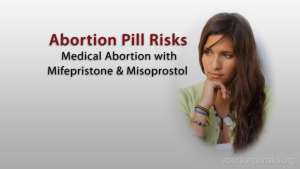Severe Pain
HEALTH RISKS: MEDICAL ABORTION SEVERE PAIN
 |
What Are The Risks?
Learn About Severe Pain of Medical Abortion.
|
On This Page:
OVERVIEW OF SEVERE PAIN
What kind of pain is associated with medical abortion?
Pain resulting from uterine cramping is an expected part of the abortion process. (1)
The severity of cramping pain associated with medical abortion ranges from mild to severe. (1)
During medical abortion with mifepristone and misoprostol, nearly all women will have abdominal pain. (2)
Abdominal pain is experienced in nearly 960-980 per 1000 women who elect to have a medical abortion. (2)
A U.S. study and prospective analysis of 77.1% (771 per 1000 women) mifepristone medical abortion patients reported significantly greater pain versus 10.5% (105 per 1000 women) who received suction curettage abortion. (3)
Women receiving mifepristone/misoprostol for medical abortion are more likely to experience significantly greater pain, nausea, vomiting, longer bleeding, and remain at risk for surgical completion curettage for several weeks than women who choose the option of a suction curettage abortion. (3) (4)
Approximately 500 per 1000 women will likely have abdominal pain that can be considered severe. (2)
In one study, approximately 295 per 1000 women cited the amount and length of pain as the worst feature of medical abortion with a median duration of 72 hours. (5)
Many women undergoing early medical abortion experience pain of a severity that requires narcotic analgesia; 23% of women experience severe pain that they rate “as almost being as bad as it can be.” (6)
If pain is severe and not relived by the use of analgesics (painkillers) and other measures (heating pad, hot water bottle, or abdominal massage), or if the pain begins more than 24 hours after taking misoprostol, the patient should contact her provider or seek medical attention right away, including going to an Emergency Room, if none of the provided contacts are unreachable. (7) (8) (See BOXED WARNINGS and WARNINGS)
PAIN IN LONGER DURATIONS OF PREGNANCY
What are women’s experiences with pain the longer duration of pregnancy?
Women who are at gestations more than 49 days have been reported to significantly receive more analgesia and opiates for severe pain than women who were 49 days’ duration or less. (2)
A higher incidence of adverse events is expected with longer durations of pregnancy. (2)
SEVERE PAIN & COMPLICATIONS
What potential health risks may be associated with severe pain during medical abortion?
The patient should immediately contact their provider if they experience severe, continuous or increasing abdominal pain. (7) (9)
Persistent or recurrent bleeding and pain may be associated with incomplete medical abortion. (4)
Patients with retained products commonly present with sharp or crampy lower abdominal pain and bleeding. (10)
Patients with intense or severe abdominal pain that may persists for longer than 4-6 hours after taking misoprostol, or if the patient reports intense, prolonged pain unrelieved with pain medicines and mild narcotics, the following possibilities should be considered: (8) (11) (12) (See WARNINGS and BOXED WARNINGS)
- Pregnancy tissue fragments trapped in the cervical opening
- Incomplete Abortion
- Ectopic Pregnancy
- Upper Reproductive Tract Infection
- Sepsis (serious infection involving the bloodstream)
- Poor pain tolerance
PATIENTS & NARCOTIC PAINKILLERS
What patient characteristics may indicate a higher use of narcotic painkillers?
The following patient characteristics emerge consistently as predictors of narcotic analgesic use: (6)
- Higher gestational age
- Younger patient age
- Lower parity (number of term births)
The proportion of women undergoing medical abortion who use narcotic analgesia varies among studies, but is generally around 750 per 1000 women. (6)
PAINKILLERS – ANALGESIC DRUG TYPES
What kind of pain drugs are used in medical abortion?
Both non-narcotic and narcotic analgesics have been used for pain control in medical abortion. (1)
Approximately 70% percent of women may receive at least one non-narcotic drug (usually acetaminophen) for abdominal pain, and 30% percent may receive narcotic painkillers (usually acetaminophen with hydrocodone, codeine or oxycodone) for severe pain. (1) (2)
HARMFUL EFFECTS OF NARCOTIC PAINKILLERS
What are the harmful effects of using narcotics for pain in medical abortion?
The harmful effects of narcotic pain medication use for medical abortion may include symptoms of lightheadedness or dizziness, sedation, nausea, and vomiting. (11)
Medications used for pain control are one of the few potentially life-threatening aspects of abortion care. (13)
It is important for providers to pay close attention to the patient’s medical history, allergies, and concurrent medications that might interact with pain drugs that are planned for use as well as following recommended dose range limits. (13)
1. National Abortion Federation. A Provider's Guide to Medical Abortion, Complications of Medical Abortion. National Abortion Federation, Early Options,. [Online] 2010. [Cited: August 2, 2011.] http://www.prochoice.org/education/cme/online_cme/m2complications.asp.
2. Spitz, Irving, et al., et al. Early Pregnancy Termination with Mifepristone and Misoprostol in the United States, 338:1241-1247. The New England Journal of Medicine, . [Online] April 30, 1998. [Cited: September 6, 2011.] http://www.nejm.org/doi/full/10.1056/NEJM199804303381801.
3. Jensen, Jeffrey T, et al., et al. Outcomes of suction curettage and mifepristone abortion in the United States: A prospective comparison study, Contraception, 59(3): 153-9. NCBI, PubMed. [Online] March 1999. [Cited: September 14, 2011.] http://www.ncbi.nlm.nih.gov/pubmed/10382077. PMID: 10382077.
4. Rorbye, C, Norgaard, M and Nilas, L. Prediction of late failure after medical abortion from serial β‐hCG measurements and ultrasonography, European Society of Human Reproduction and Embryology, Volume 19, Issue1, Pp. 85-89. Oxford Journals, Human Reproduction. [Online] 2004. [Cited: September 8, 2011.] http://humrep.oxfordjournals.org/content/19/1/85.full. Online ISSN 1460-2350 – Print ISSN 0268-1161.
5. Shannon, Caitlin S, et al., et al. Multicenter Trial of a Simplified Mifepristone Medical Abortion Regimen, Volume 105, Issue 2. Obstetrics & Gynecology, The American College of Obstetricians and Gynecologists . [Online] February 2005. [Cited: September 7, 2011.] http://journals.lww.com/greenjournal/fulltext/2005/02000/multicenter_trial_of_a_simplified_mifepristone.22.aspx.
6. Penney, Gillian. Treatment of pain during medical abortion, Contraception 74(1):45-7 . [Online] July 2006. [Cited: September 8, 2011.] http://www.ncbi.nlm.nih.gov/pubmed/16781260. PMID: 16781260.
7. National Abortion Federation. Management of Side Effects and Complications in Medical Abortion: A Guide for Triage and On-Call Staff. Early Options, National Abortion Federation. [Online] September 2008. [Cited: August 31, 2011.] http://www.prochoice.org/pubs_research/publications/downloads/professional_education/medical_abortion/phone_triage_guide.pdf.
8. Danco Laboratories, LLC. Health Professionals, Prescribing Information. Mifeprex, (Mifepristone) the early option pill to end pregnancy. [Online] 2011. [Cited: July 28, 2011.] http://www.earlyoptionpill.com/section/health_professionals/prescribing_information/.
9. IPPF, Vekemans, Marcel. First trimester abortion guidelines and protocols. Surgical and medical procedures. International Planned Parenthood Federation. [Online] September 2008. [Cited: May 25, 2011.] www.ippf.org/system/files/abortion_guidelines_and_protocol_english.pdf
10. Lichtenberg, Steve, Grimes, David and Paul, Maureen. A Clinician's Guide to Medical and Surgical Abortion. s.l. : A Churchill Livingstone title, 1999. ISBN # 0-443-07529-8.
11. Kruse, Beth, et al., et al. Management of side effects and complications in medical abortion, Am J Obstet Gynecol. Vol 183, Number2. NCBI, PubMed. [Online] August 2000. [Cited: September 6, 2011.] http://www.ncbi.nlm.nih.gov/pubmed/10944371.
12. IPAS. Medical Abortion Training Resources, Medical Abortion Study Guide, Using medicines for first-trimester pregnancy termination. IPAS. [Online] 2009. [Cited: September 8, 2011.] http://www.ipas.org/Publications/Medical_abortion_training_resources_%5BMulti-language_CD%5D.aspx. ISBN: 1-933095-46-6.
13. Goodman, S and Wolfe, M. Early Abortion Trainers Workbook, Second Edition. Bixby Center for Global Reproductive Health , UCSF – ANSIRH, Advancing New Standards in Reproductive Health. [Online] 2007. [Cited: September 2, 2011.] http://www.ansirh.org/training/workbook.php.
Page Last Updated: 7/25/2012



Comments on this entry are closed.